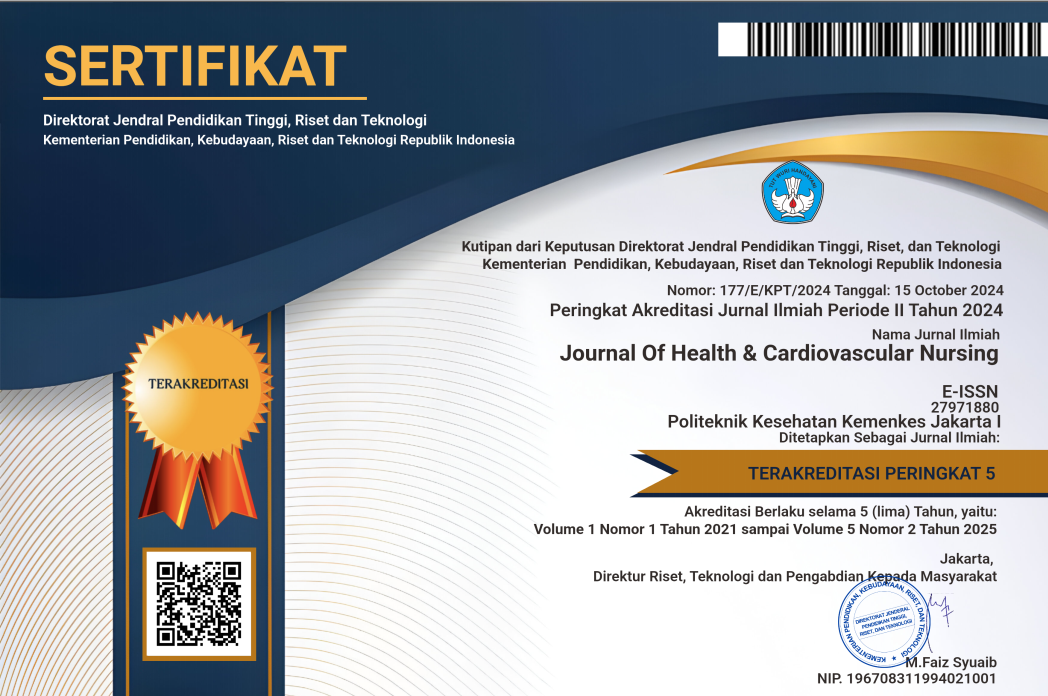Family Independence Increases Post-Stroke Patient’s Ability to Daily Activities
Kemandirian Keluarga Meningkatkan Kemampuan Aktivitas Sehari-hari Pasien Pasca-Stroke
Keywords:
Tingkat Kemandirian, Aktivitas Kehidupan sehari-hari, StrokeAbstract
Stroke is the main cause of disability which results in post-stroke patients needing family caregiver assistance in theirdaily lives. Family independence is needed to improve the ability to perform daily life activities of post-stroke patients.The purpose of this study was to identify the relationship between the level of family independence and the frequency ofstroke attacks on the ability of daily life activities of post-stroke patients. This research method uses a cross-sectionalresearch design. The study population was 420 people. The sample in the study used cluster sampling with a total samplesize of 206 respondents. The results of the chi-square test showed that there was a significant relationship between thelevel of family independence and the ability to daily life activities of post-stroke patients (p=0.000) and there was asignificant relationship between the frequency of stroke attacks on the ability to daily life activities of post-stroke patients(p=0.001) <a-0.05. Good family independence is that the family can apply the seven indicators that have been determined.The better the level of family Idependence in post-stroke patients in the recovery process, the better the ability of dailylife activities. In conclusion, this study proves that a fairly good level of family independence can affect the ability of dailylife activities of post-stroke patients which is quite good as well, and repeated stroke attacks will also affect the ability todaily life activities of post-stroke patients due to the disability experienced by then getting heavier, therefore it is necessary to conduct counseling on family health tasks to increase the level of family independence in caring for post-stroke patients at home and prevent repeated strokes.Downloads
References
Anita, Fransiska (2021). Efektifitas Perilaku Cerdik Dan Patuh Untuk Mencegah Stroke Berulang. Jurnal Ilmiah Kesehatan Sandi Husada. Vol. 10 No. 1 https://journal.ppnijateng.org/index.php/ jikmb/article/view/779
Ariska, Y. N., Handayani, P. A., & Hartati, E. (2020). Faktor yang Berhubungan dengan Beban Caregiver dalam Merawat Keluarga yang Mengalami Stroke. Holistic Nursing and Health Science, 3(1), 52–63. https://doi.org/10.14710/hnhs.3.1.2020.52-63
Kaur, P., Bhalla, A., Katyal, P., Raavi, Kaur, R., Kaur, R., Kaur Bhangu, R., Kaur, R., & Kaur, S. (2018). Strain among the Family Caregivers of Patients with Stroke. Journal of Perioperative & Critical Intensive Care Nursing, 04(02), 2–5. https://doi.org/10.4172/2471-9870.10000144
Kertapati, Y. (2019). Tugas Kesehatan Keluarga dan Tingkat Kemandirian Keluarga di Wilayah Pesisir Kota Surabaya Yoga Kertapati Sekolah Tinggi Ilmu Kesehatan Hang Tuah Surabaya Pendahuluan. 14(1), 1–10
Kurniasih, H., Purnanti, K.D., & Atmajaya, R. (2022). Pengembangan Sistem Informasi Penyakit Tidak Menular (PTM) Berbasis Teknologi Informasi. Jurnal Teknoinfo, 16(1), 60 - 65. https://ejurnal.teknokrat.ac.id/index.php/teknoinfo/article/view/1510
Lestari R., Warseno A., Trisetyaningsih, Y., Rukmi, D. K., & Suci, A. (2020). Pemberdayaan Kader Kesehatan dalam Mencegah Penyakit Tidak Menular melalui Posbindu PTM. Adimas: Jurnal Pengabdian Kepada Masyarakat, 4(1), 48-55. https://doi.org/10.24269/adi.v4il.2439.
Nofrel, V., Lukman, M., & Mambang Sari, C. W. (2020). Pengaruh Latihan Range Of Motion terhadap Peningkatan Kemampuan Melakukan Activity Daily Living pada Penderita Pasca Stroke. Jurnal Ilmiah Universitas Batanghari Jambi, 20(2), 564.
Riskesdas. (2018). Laporan Provinsi Kalimantan Barat RISKESDAS 2018. Dinas Kesehatan Kalimantan Barat, 1–493. https://dinkes.kalbarprov.go.id/wp-content/uploads/2019/05/Laporan-RKD-2018-Kalbar.pdf
Thalib, A. H. S., & Saleh, F. J. (2022). Efektivitas Teknik Kebebasan Emosional Spiritual Pada Peningkatan Kualitas Hidup Pada Pasien Pasca Stroke. Jurnal Ilmiah Kesehatan Sandi Husada, 11(1), 82–88. https://doi.org/10.35816/jiskh.v11i1.709
Witriastuti, A., Aris, A., Suhariyati, & Rahmawati, S. A. (2023). Hubungan Dukungan Keluarga Dengan Tingkat Kemandirian dalam Activity Daily Living (ADL) pada Pasien Pasca Stroke. Journal Universitas Muhammadiyah Lamongan, 4(2828–7509), 1–11.
Wulandari, C. I., & Herlina, N. (2021). Hubungan Antara Gaya Hidup Dengan Kejadian Stroke Berulang: Literature Review. Borneo Student Research, 2(3), 1781–1788.
Zhuo, Y., Wu, J., Qu, Y., Yu, H., Huang, X., Zee, B., … Yang, Z. (2020). Clinical risk factors associated with recurrence of ischemic stroke within twoyears: A cohort study. Medicine, 99(26), e20830.https://doi.org/10.1097/MD.0000000000020830
Published
Issue
Section
Copyright (c) 2024 Journal of Health and Cardiovascular Nursing

This work is licensed under a Creative Commons Attribution-ShareAlike 4.0 International License.









